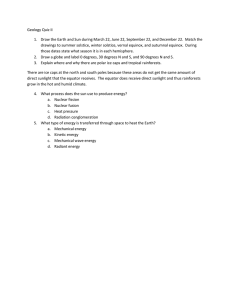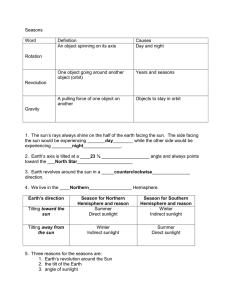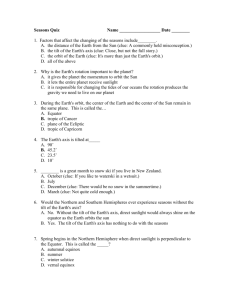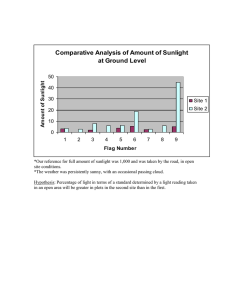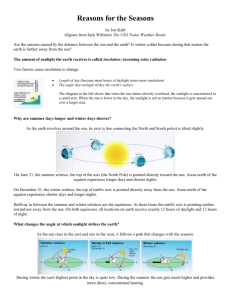Earth rotates on a tilted axis and orbits the Sun.
advertisement
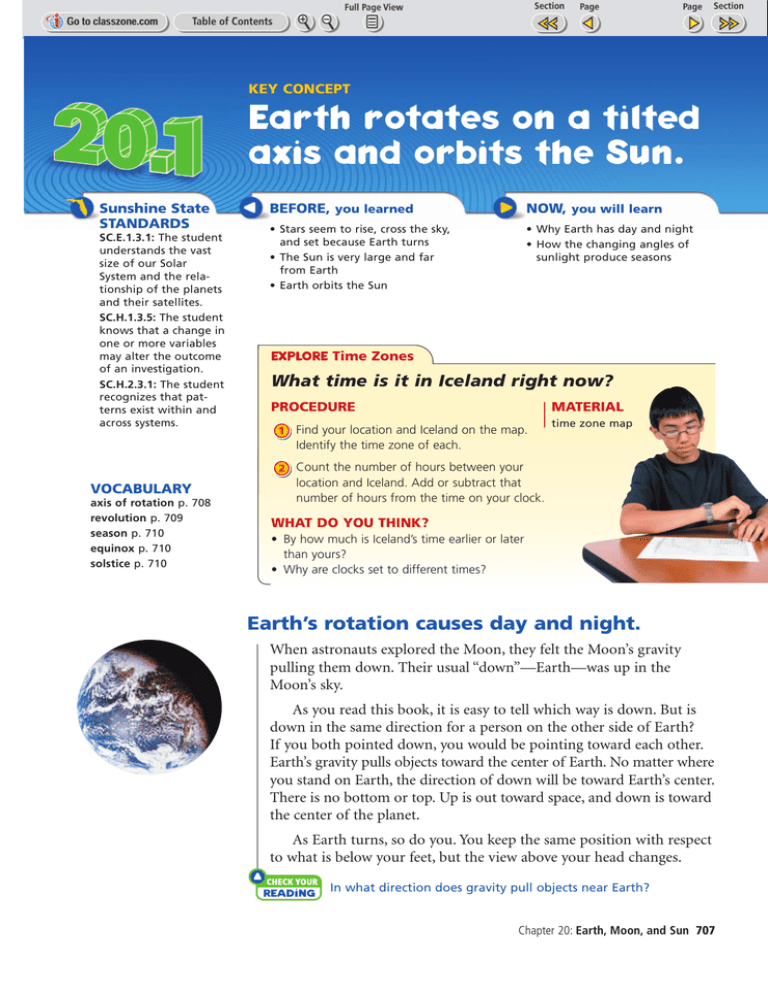
KEY CONCEPT Earth rotates on a tilted axis and orbits the Sun. Sunshine State STANDARDS SC.E.1.3.1: The student understands the vast size of our Solar System and the relationship of the planets and their satellites. SC.H.1.3.5: The student knows that a change in one or more variables may alter the outcome of an investigation. SC.H.2.3.1: The student recognizes that patterns exist within and across systems. BEFORE, you learned NOW, you will learn • Stars seem to rise, cross the sky, and set because Earth turns • The Sun is very large and far from Earth • Earth orbits the Sun • Why Earth has day and night • How the changing angles of sunlight produce seasons EXPLORE Time Zones What time is it in Iceland right now? PROCEDURE 1 MATERIAL Find your location and Iceland on the map. Identify the time zone of each. time zone map 2 Count the number of hours between your VOCABULARY axis of rotation p. 708 revolution p. 709 season p. 710 equinox p. 710 solstice p. 710 location and Iceland. Add or subtract that number of hours from the time on your clock. WHAT DO YOU THINK? • By how much is Iceland’s time earlier or later than yours? • Why are clocks set to different times? Earth’s rotation causes day and night. When astronauts explored the Moon, they felt the Moon’s gravity pulling them down. Their usual “down”—Earth—was up in the Moon’s sky. As you read this book, it is easy to tell which way is down. But is down in the same direction for a person on the other side of Earth? If you both pointed down, you would be pointing toward each other. Earth’s gravity pulls objects toward the center of Earth. No matter where you stand on Earth, the direction of down will be toward Earth’s center. There is no bottom or top. Up is out toward space, and down is toward the center of the planet. As Earth turns, so do you. You keep the same position with respect to what is below your feet, but the view above your head changes. check your reading In what direction does gravity pull objects near Earth? Chapter 20: Earth, Moon, and Sun 707 noon The globe and the flat map show the progress of daylight across Earth in two ways. This location is experiencing sunrise. midnight The directions north, south, east, and west are based on the way the planet rotates, or turns. Earth rotates around an imaginary line running through its center called an axis of rotation. The ends of the axis are the north and south poles. Any location on the surface moves from west to east as Earth turns. If you extend your right thumb and pretend its tip is the North Pole, then your fingers curve the way Earth rotates. At any one time, about half of Earth is in sunlight and half night moves is dark. However, Earth turns on westward its axis in 24 hours, so locations move through the light and darkness in that time. When a location is in sunlight, it is daytime there. When a location is in the middle of the sunlit side, it is noon. When a location is in darkness, it is night there, and when the location is in the middle of the unlit side, it is midnight. check your reading If it is noon at one location, what time is it at a location directly on the other side of Earth? Rotation What causes day and night? SKILL FOCUS Making models In this model the lamp represents the Sun, and your head represents Earth. The North Pole is at the top of your head. You will need to imagine locations on your head as if your head were a globe. PROCEDURE 1 Face the lamp and hold your hands to your face as shown in the photograph. Your hands mark the horizon. For a person located at your nose, the Sun would be high in the sky. It would be noon. 2 Face away from the lamp. Determine what time it would be at your nose. 3 Turn to your left until you see the lamp along your left hand. 4 Continue turning to the left, through noon, until you just stop seeing the lamp. WHAT DO YOU THINK? • What times was it at your nose in steps 2, 3, and 4? • When you face the lamp, what time is it at your right ear? CHALLENGE How can a cloud be bright even when it is dark on the ground? 708 Unit 6: Space Science MATERIALS lamp TIME 15 minutes Earth’s tilted axis and orbit cause seasons. Just as gravity causes objects near Earth to be pulled toward Earth’s center, it also causes Earth and other objects near the Sun to be pulled toward the Sun’s center. Fortunately, Earth does not move straight into the Sun. Earth moves sideways, at nearly a right angle to the Sun’s direction. Without the Sun’s gravitational pull, Earth would keep moving in a straight line out into deep space. However, the Sun’s pull changes Earth’s path from a straight line to a round orbit about 300 million kilometers (200,000,000 mi) across. Just as a day is the time it takes Earth to rotate once on its axis, a year is the time it takes Earth to orbit the Sun once. In astronomy, a revolution is the motion of one object around another. The word revolution can also mean the time it takes an object to go around once. Earth’s rotation and orbit do not quite line up. If they did, Earth’s equator would be in the same plane as Earth’s orbit, like a tiny hoop and a huge hoop lying on the same tabletop. Instead, Earth rotates at about a 23˚ angle, or tilt, from this lined-up position. reading tip Use the second vowel in each word to help you remember that an object rotates on its own axis, but revolves around another object. Not to scale 23° orbit 23° Earth’s axis points in a constant direction as Earth orbits the Sun. Earth is tilted 23˚ from its orbit. Use your thumb to represent the North Pole. Keep it steady as you move your hand in a counterclockwise circle on a tabletop. As Earth moves, its axis always points in the same direction in space. You could model Earth’s orbit by moving your right fist in a circle on a desktop. You would need to point your thumb toward your left shoulder and keep it pointing that way while moving your hand around the desktop. Earth’s orbit is not quite a perfect circle. In January, Earth is about 5 million kilometers closer to the Sun than it is in July. You may be surprised to learn that this distance makes only a tiny difference in temperatures on Earth. However, the combination of Earth’s motion around the Sun with the tilt of Earth’s axis does cause important changes of temperature. Turn the page to find out how. July 153,000,000 km 148,000,000 km January Not to scale Earth’s orbit is almost a circle. Earth’s distance from the Sun varies by only about 5,000,000 km—about 3%—during a year. Chapter 20: Earth, Moon, and Sun 709 VOCABULARY Remember to put each new term into a frame game diagram. Seasonal Patterns Most locations on Earth experience seasons, patterns of temperature changes and other weather trends over the course of a year. Near the equator, the temperatures are almost the same year-round. Near the poles, there are very large changes in temperatures from winter to summer. The temperature changes occur because the amount of sunlight at each location changes during the year. The changes in the amount of sunlight are due to the tilt of Earth’s axis. Look at the diagram on page 711 to see how the constant direction of Earth’s tilted axis affects the pattern of sunlight on Earth at different times of the year. As Earth travels around the Sun, the area of sunlight in each hemisphere changes. At an equinox (EE-kwuh-NAHKS), sunlight shines equally on the northern and southern hemispheres. Half of each hemisphere is lit, and half is in darkness. As Earth moves along its orbit, the light shifts more into one hemisphere than the other. At a solstice (SAHL-stihs), the area of sunlight is at a maximum in one hemisphere and a minimum in the other hemisphere. Equinoxes and solstices happen on or around the 21st days of certain months of the year. 1 When Earth is in this position, sunlight shines equally on the two hemispheres. You can see in the diagram that the North Pole is at the border between light and dark. The September equinox marks the beginning of autumn in the Northern Hemisphere and of spring in the Southern Hemisphere. 2 Three months later, Earth has traveled a quarter of the way around the Sun, but its axis still points in the same direction into space. The North Pole seems to lean away from the direction of the Sun. The solstice occurs when the pole leans as far away from the Sun as it will during the year. You can see that the North Pole is in complete darkness. At the same time, the opposite is true in the Southern Hemisphere. The South Pole seems to lean toward the Sun and is in sunlight. It is the Southern Hemisphere’s summer solstice and the Northern Hemisphere’s winter solstice. 3 After another quarter of its orbit, Earth reaches another equinox. Half of each hemisphere is lit, and the sunlight is centered on the equator. You can see that the poles are again at the border between day and night. 4 June Solstice reading tip The positions and lighting can be hard to imagine, so you might use a model as well as the diagram on the next page to help you understand. September Equinox December Solstice March Equinox This position is opposite the December solstice. Earth’s axis still points in the same direction, but now the North Pole seems to lean toward the Sun and is in sunlight. The June solstice marks the beginning of summer in the Northern Hemisphere. In contrast, it is the winter solstice in the Southern Hemisphere. check your reading 710 Unit 6: Space Science In what month does winter begin in the Southern Hemisphere? Seasons Earth’s orbit and steady, tilted axis produce seasons. 1 4 June Solstice More than half of the Northern Hemisphere is in sunlight. The strongest sunlight is north of the equator, so the Northern Hemisphere grows warmer. September Equinox Half of the sunlight is in each hemisphere. The strongest sunlight is on the equator. 2 December Solstice Less than half of the Northern Hemisphere is in sunlight. The strongest sunlight is south of the equator, so the Southern Hemisphere grows warmer. 3 Not to scale March Equinox Half of the sunlight is in each hemisphere. The strongest sunlight is on the equator. View from the Sun If you could stand on the Sun and look at Earth, you would see different parts of Earth at different times of year. fall winter spring summer spring summer fall winter 1 September Equinox 2 December Solstice 3 March Equinox 4 June Solstice The equinoxes and solstices mark the beginnings of seasons in the two hemispheres. Warmer seasons occur when more of a hemisphere is in sunlight. Look at the poles to help you see how each hemisphere is lit. When is the South Pole completely in sunlight? Chapter 20: Earth, Moon, and Sun 711 RESOURCE CENTER CLASSZONE.COM Learn more about seasons. FLORIDA Angles of Sunlight You have seen that seasons change as sunlight shifts between hemispheres during the year. On the ground, you notice the effects of seasons because the angle of sunlight and the length of daylight change over the year. The effects are greatest at locations far from the equator. You may have noticed that sunshine seems barely warm just before sunset, when the Sun is low in the sky. At noon the sunshine seems much hotter. The angle of light affects the temperature. Content Review When the Sun is high in the sky, sunlight strikes the ground at close to a right angle. The energy of sunlight is concentrated. Shadows are short. You may get a sunburn quickly when the Sun is at a high angle. When the Sun is low in the sky, sunlight strikes the ground at a slant. The light is spread over a greater area, so it is less concentrated and produces long shadows. Slanted light warms the ground less. reminder Notice how the angle of sunlight affects the climate of a region, which you studied in grade 6. Near the equator, the noonday Sun is almost overhead every day, so the ground is warmed strongly year-round. In the middle latitudes, the noon Sun is high in the sky only during part of the year. In winter the noon Sun is low and warms the ground less strongly. check your reading How are temperatures throughout the year affected by the angles of sunlight? Sun Height and Shadows Winter Solstice, 12 P.M. Spring Equinox, 12 P.M. Summer Solstice, 12 P.M. Winter shadows are long because sunlight is spread out. The Sun appears low in the sky even at noon. Spring and fall shadows are of medium length, and the noon Sun appears higher in the sky. Summer shadows are short because the light is concentrated in a small area. The noon Sun appears high in the sky. location on Earth 712 Unit 6: Space Science midnight 6 A.M. noon 6 P.M. Near the pole in the summer, the Sun stays above the horizon, so there is no night. This series of photographs was taken over the course of a day. Lengths of Days Seasonal temperatures depend on the amount of daylight, too. In Chicago, for example, the summer Sun heats the ground for about 15 hours a day, but in winter there may be only 9 hours of sunlight each day. The farther you get from the equator, the more extreme the changes in day length become. As you near one of the poles, summer daylight may last for 20 hours or more. Very close to the poles, the Sun does not set at all for six months at a time. It can be seen shining near the horizon at midnight. Tourists often travel far north just to experience the midnight Sun. At locations near a pole, the Sun sets on an equinox and then does not rise again for six months. Astronomers go to the South Pole in March to take advantage of the long winter night, which allows them to study objects in the sky without the interruption of daylight. reading tip Equinox means “equal night”—daylight and nighttime are equal in length. Very near the equator, the periods of daylight and darkness are almost equal year-round—each about 12 hours long. Visitors who are used to hot weather during long summer days might be surprised when a hot, sunny day ends suddenly at 6 P.M. At locations away from the equator, daylight lasts 12 hours only around the time of an equinox. KEY CONCEPTS CRITICAL THINKING 1. What causes day and night? 4. Apply If you wanted to enjoy longer periods of daylight in the summertime, would you head closer to the equator or farther from it? Why? 2. What happens to Earth’s axis of rotation as Earth orbits the Sun? 3. How do the areas of sunlight in the two hemispheres change over the year? 5. Compare and Contrast How do the average temperatures and the seasonal changes at the equator differ from those at the poles? CHALLENGE 6. Infer If Earth’s axis were tilted so much that the North Pole sometimes pointed straight at the Sun, how would the hours of daylight be affected at your location? Chapter 20: Earth, Moon, and Sun 713
